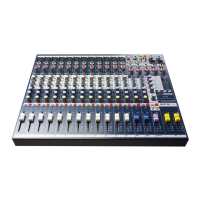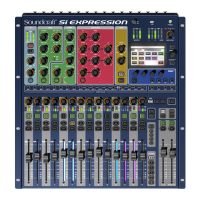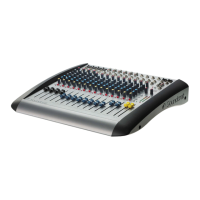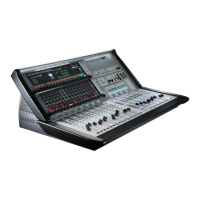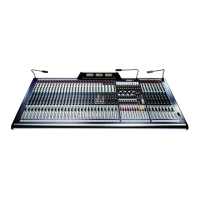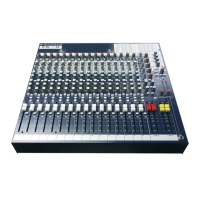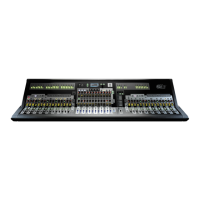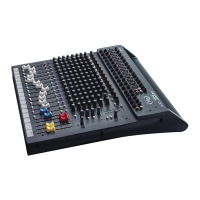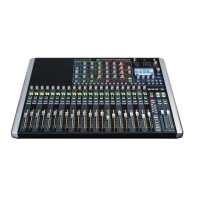Do you have a question about the SoundCraft EFX and is the answer not in the manual?
Details the meaning of the lightning flash symbol indicating dangerous voltage.
Explains the exclamation point symbol for important operating and maintenance instructions.
Quick guide to EFX console features, identifying controls by number.
Details on using XLR connectors for balanced/unbalanced mic signals and phantom power.
Instructions for connecting line-level sources using TRS or mono jacks.
Explains the XLR mic input, its impedance, and phantom power considerations.
Details the TRS line input for keyboards, drum machines, etc., and its balanced nature.
Explains how the gain control sets the input signal level and its impact on distortion and noise.
Details the HF, Mid, and LF EQ controls for shaping the sound of input channels.
Describes the 60mm fader for controlling overall channel signal level.
Explains the Pre-Fade Listen function for monitoring individual channels.
Describes the peak LED indicator for signal clipping at various points.
Explains the gain control for setting the level of the stereo channel signal.
Details the HF, Mid, and LF EQ controls for shaping the sound of stereo input channels.
Describes the fader for controlling overall stereo channel signal level.
Explains the Pre-Fade Listen function for monitoring individual stereo channels.
Describes the peak LED indicator for signal clipping on stereo channels.
Explains phantom power for condenser mics and safety warnings.
Step-by-step guide on selecting and setting up effects, including audio levels.
Knob for navigating and selecting between 32 programs in two banks.
Fader controlling the level of the effects processor output to the main mix.
Controls the time delay between source signal and reverb onset.
Controls the duration of the reverb tail.
Adjusts the high-frequency content in the reverb tail.
Controls the initial echo density and how sound reflects off surfaces.
Influences the sense of room shape and size by shaping the reverb tail energy.
Controls delay length relative to Tap Tempo.
Discusses microphone pick-up patterns and placement for effective sound reinforcement.
Step-by-step guide for setting initial control positions and input levels.
The 'howling' sound caused by microphone proximity to a loudspeaker.
The amount of amplification in the level of the signal.
Visual indicator of signal peaking before clipping.
Pre-fade listen function to monitor individual channels.
Details the meaning of the lightning flash symbol indicating dangerous voltage.
Explains the exclamation point symbol for important operating and maintenance instructions.
Quick guide to EFX console features, identifying controls by number.
Details on using XLR connectors for balanced/unbalanced mic signals and phantom power.
Instructions for connecting line-level sources using TRS or mono jacks.
Explains the XLR mic input, its impedance, and phantom power considerations.
Details the TRS line input for keyboards, drum machines, etc., and its balanced nature.
Explains how the gain control sets the input signal level and its impact on distortion and noise.
Details the HF, Mid, and LF EQ controls for shaping the sound of input channels.
Describes the 60mm fader for controlling overall channel signal level.
Explains the Pre-Fade Listen function for monitoring individual channels.
Describes the peak LED indicator for signal clipping at various points.
Explains the gain control for setting the level of the stereo channel signal.
Details the HF, Mid, and LF EQ controls for shaping the sound of stereo input channels.
Describes the fader for controlling overall stereo channel signal level.
Explains the Pre-Fade Listen function for monitoring individual stereo channels.
Describes the peak LED indicator for signal clipping on stereo channels.
Explains phantom power for condenser mics and safety warnings.
Step-by-step guide on selecting and setting up effects, including audio levels.
Knob for navigating and selecting between 32 programs in two banks.
Fader controlling the level of the effects processor output to the main mix.
Controls the time delay between source signal and reverb onset.
Controls the duration of the reverb tail.
Adjusts the high-frequency content in the reverb tail.
Controls the initial echo density and how sound reflects off surfaces.
Influences the sense of room shape and size by shaping the reverb tail energy.
Controls delay length relative to Tap Tempo.
Discusses microphone pick-up patterns and placement for effective sound reinforcement.
Step-by-step guide for setting initial control positions and input levels.
The 'howling' sound caused by microphone proximity to a loudspeaker.
The amount of amplification in the level of the signal.
Visual indicator of signal peaking before clipping.
Pre-fade listen function to monitor individual channels.
| Channels quantity | 10 channels |
|---|
| Depth | 362 mm |
|---|---|
| Width | 91 mm |
| Height | 330 mm |
| Weight | 4600 g |

